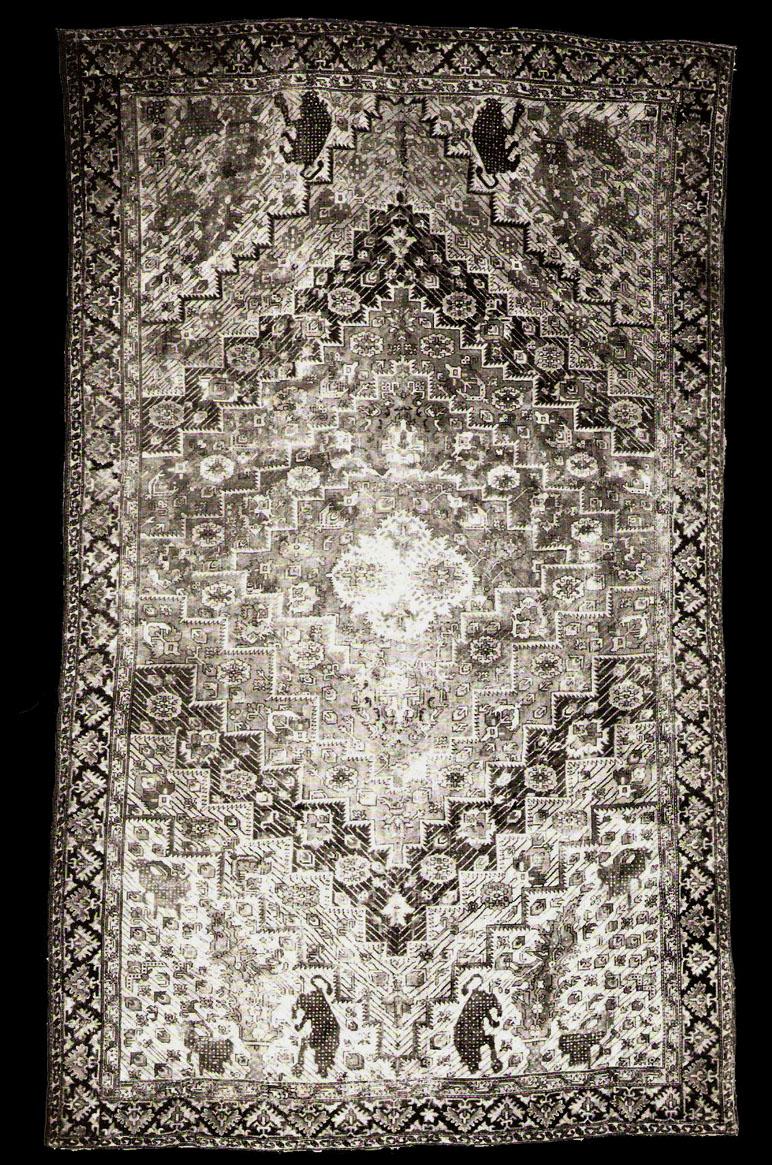|
Rug in "Portuguese" Carpet Design. Provenance Unknown. Textile Museum
R 36.00.2 (formerly R 2.71). 18th century
This rug appears to be a free copy of Plate
31 in the wrong proportions: too broad for its length, and in coloring that
is now too pastel, lacking the clarity and snap that are characteristic of
the early Caucasian products. The central feature, which is more rotund than
in Plate 31, is ivory. Aside from its four palmettes in orange and blue or
green, it appears stuffed with little cocoons in light green. This
centerpiece is surrounded by concentric stepped bands in light red, light
green, light red, brown, light yellow. These bands bear disconnected
rosettes and buds in various colors. Lotus palmette forms on the central
axis, which are found near the ends of the field in the earlier "Portuguese"
carpets, have been injected into the design, not far from the centerpiece.
The spandrels are ivory.
The little bird forms seen in Plate 31 have been eliminated in favor of buds
and leaves ranged in rows, while over the spandrels and bands is laid a
sheet of diagonal lines like driving rain. They are quite puzzling, and may
have been suggested by the transverse wear lines in Plate 31, caused by the
thick single weft shots as the pile has become more sparse. The black-brown
border stripe presents alternately opposed triangular palmette forms, each
linked to a pair of little leaf-like halved palmettes. The inner guard
stripe is yellow, except for the lower border, where it is ivory. It shows a
well-known Persian vine with diagonal palmettes and tricleft leaves. The
outer guard stripe is ivory, with a red and blue vine.
The border pattern occurs as a single border stripe in several rugs that
were among the first "Armenian" or "Kupa" carpets to be published: the "Gohar"
rug with its Armenian inscription, now in the Fiesta Collection in Milan and
the Jackling dragon rug in the California Palace of the Legion of Honor in
San Francisco (Martin 1908: Figs. 296, 295). In Kendrick and Tattersall
(1922: p. 15) it is indicated that the "Gohar" carpet was photographed at
the Victoria and Albert Museum in London in 1899, whereupon it left the
country. The border of Plate 32 may have been copied from this rug, with the
guard stripes added as disguise. The pattern of the inner guard stripe is
not familiar among the early Caucasian carpets.
The lengthwise cut can only have deprived the rug of a few centimeters of
breadth. In the same way, little can have been lost by the transverse
cutting, for the central motif has not been impinged upon. The offsets at
which these cuts cross the borders seem so wide as to contradict the
slightness of these losses. In fact they would not have occurred if these
divisions in the carpet had been caused by repeated folding along the same
lines, which has caused the centers of so many carpets to fail. In the lower
spandrels blocks which individually contain the two bulls and one of the
goats appear to have been cut out of the carpet and then replaced in the
same positions. Has there been too much work with the shears? The presence
of stout single wefts, irregularly spaced, gives the appearance of the old
craft practice. Still, these do not seem as heavy and complex as in the old
examples, and they do not produce the same lines of wear on the face of the
rug. The use of so much ivory wool in warp and weft is, to say the least,
unusual, for it was evidently the habit in the Southern Caucasus to use up
dark fibers in the foundation and save the white for the pile.
The soft wool of the warps, the truncated format, the peculiarities of
drafting and cutting, and above all the rather pastel color scheme, with an
uneven, mottled brown which is quite uncharacteristic of the early Caucasian
carpets, raise too many doubts in my mind for me to include this among the
antique carpets of the collection.
Size: L. 3.55 m. (H'8") x W. 2.06 m. (6'9").
Warp: Z2S soft wool in ivory with a few dark fibers or light natural blends.
In part of the carpet, dark mixtures of natural shades and a few barberpoles.
Alternate warps depressed.
Weft: Z2S wool in ivory and light mixtures dyed pale red. In parts of the
carpet the dye is a good red and in another place, light violet. Two shots.
At variable intervals heavy single shots, as Z4S or 4Z, dyed red.
Pile: Z2S winder ply wool. Gordes knotting, pile slanting to left. 10 or 9
horiz. x 9+ or 11 vert, per in. (92 to 100 per sq.in.).
Sides: Cut. Ends: Cut.
Colors: Ivory; black-brown; dark medium brown (abrashed black-brown); light
orange; light greenish yellow; light red; light medium and light blues;
light green; violet.
Charles Ellis,
Early Caucasian Rugs, Textile Museum, Washington D.C., 1975, plate 32
|
 |

